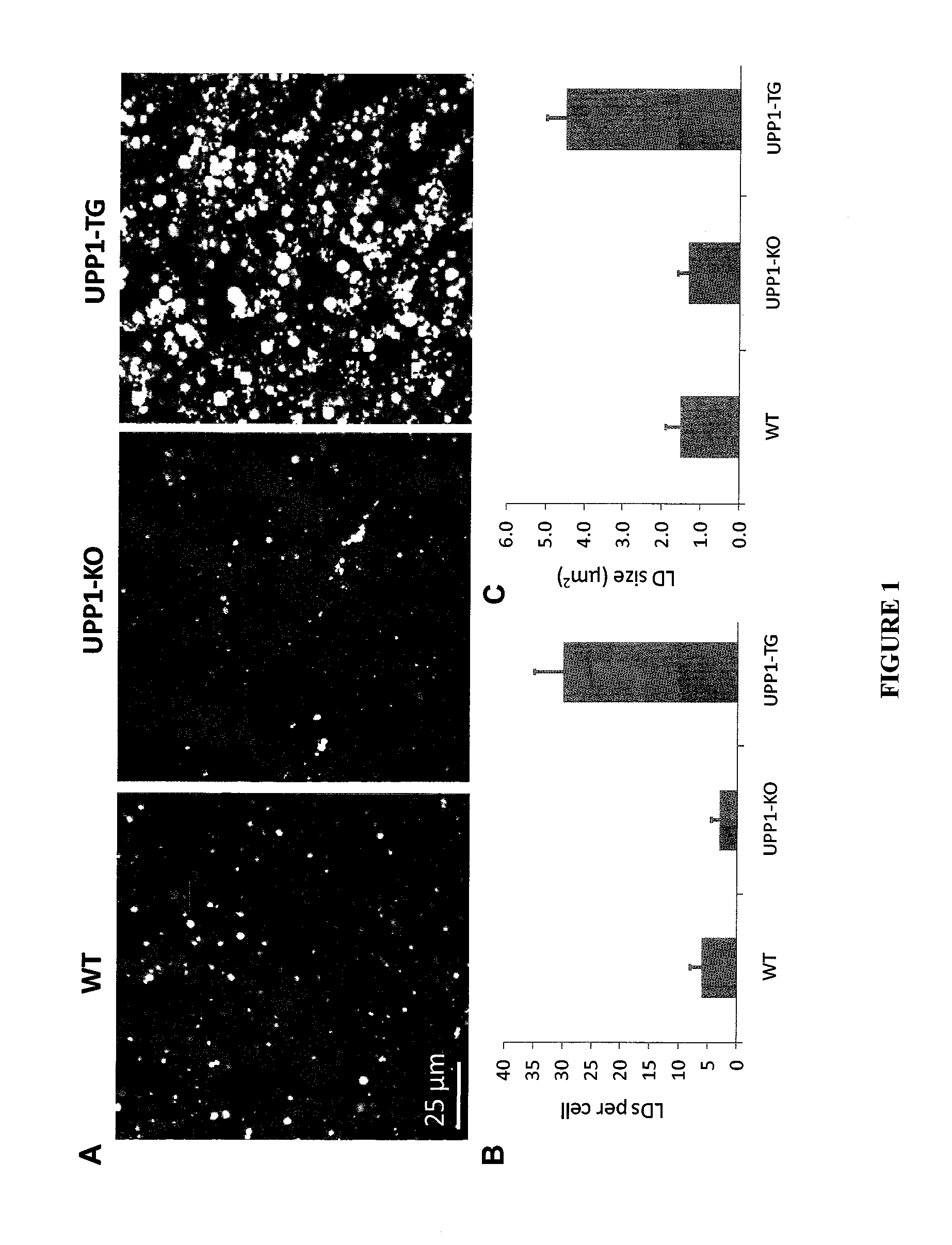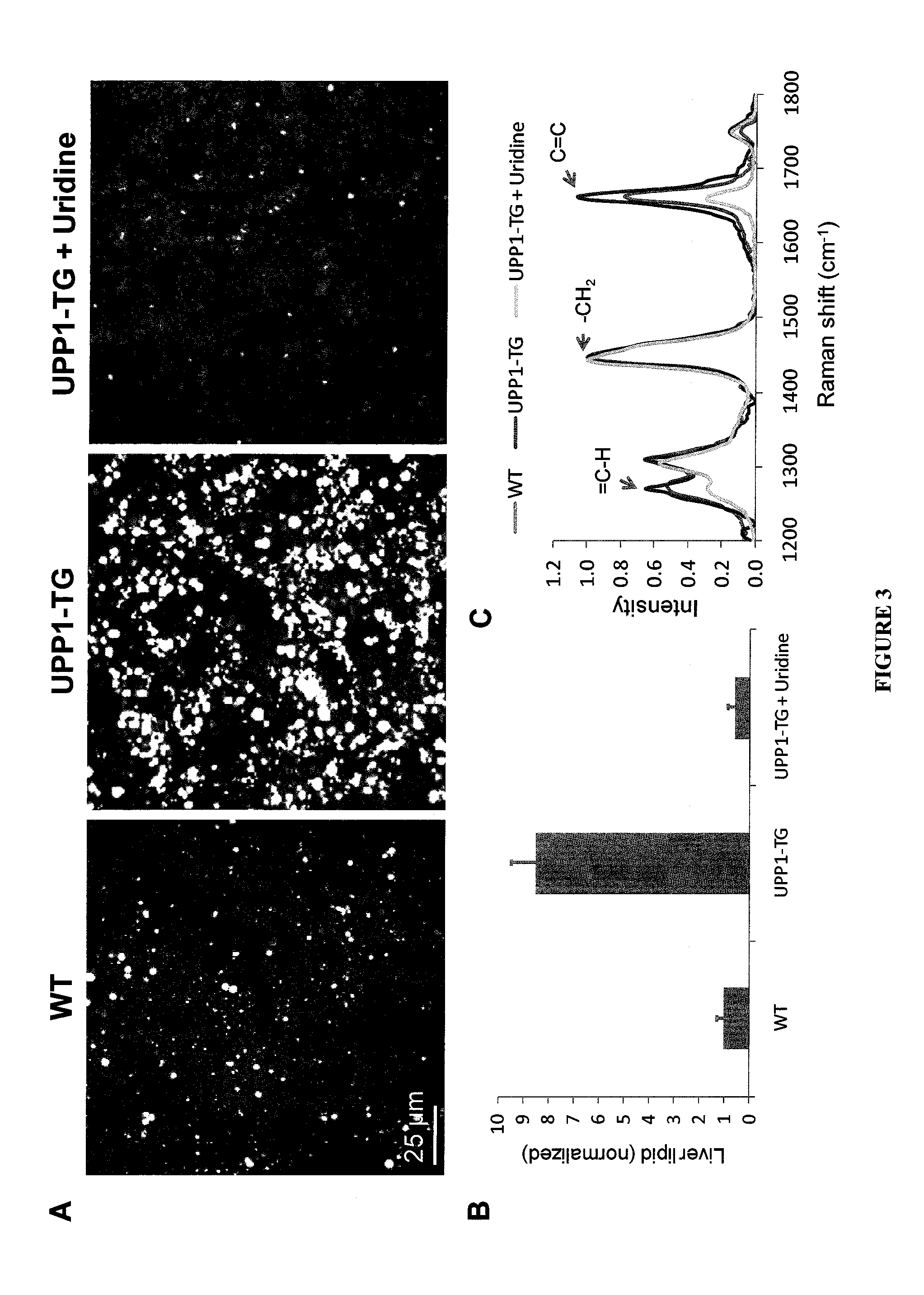Methods for Treating Fatty Liver Disease
a technology for fatty liver and formulation, applied in the field of compositions, formulations and methods of treating fatty liver disorders, can solve the problems of fatty liver scarring and hardening, no established medical treatment for fatty liver, and no clear treatment currently available for nafld treatment, etc., to increase the serum half-life of uridine and increase the absorption of uridine
- Summary
- Abstract
- Description
- Claims
- Application Information
AI Technical Summary
Benefits of technology
Problems solved by technology
Method used
Image
Examples
example 1
Generation and Characterization of UPP-1 Knockout and Transgenic Mice
[0087]The UPP-1-KO mouse was created by replacing a 2.5 kb fragment of the UPP-1 gene (including exons 4 and 5) with a 1.6 kb neomycin resistance expression cassette. See, e.g., Cao, D. et al. (2002) Cancer Res. 62: 2313-2317 and Cao, D. et al. (2005) J. Biol. Chem. 280: 21169-21175. A three to four-fold increase in the circulating plasma level of uridine (Urd) was observed in UPP-1-KO mice. The absence of UPP-1 phosphorolytic (UPase) activity was confirmed by determining the fate of a tracer dose (25 μCi / mouse) of [3H]Urd injected intraperitoneally (i.p.) in mice. A very rapid disappearance of [3H]Urd from the plasma of wild-type (WT) mice was observed, with a t1 / 2, of approximately 3 minutes due to active phosphorolysis. In contrast, [3H]Urd t1 / 2, was approximately 15-18 minutes in UPP-1-KO mice.
[0088]The abrogation of UPase activity in tissues has not only resulted in dramatic changes in Urd metabolism but also ...
example 2
Role of Uridine in the Regulation of Lipid Accumulation in the Liver
[0098]Uridine, through its catabolites, contributes directly to the synthesis of fatty acids (de novo lipogenesis). Therefore, high uridine degradation in UPPI-TG mice provides a high quantity of precursors for de novo lipid synthesis leading to increased hepatic lipid accumulation. It was found that the drastic reduction of URD concentration in UPP-1-TG mice compared to WT liver tissue, (0.5 M versus 6.4 respectively) is associated with a significant increase in the tissue concentration of -alanine (186.9 and 80.8 M for UPP-1-TG and WT liver respectively). β-alanine is the final product of the degradation of URD and represents the rate-limiting precursor in the formation of carnosine, an antioxidant able to scavenge reactive oxygen species (ROS) as well as α / β unsaturated aldehydes formed from peroxidation of cell membrane fatty acids during oxidative stress. More importantly, β-alanine is a constituent of acetyl-C...
example 3
Roles of UPP-1 and UPP-2 in Lipid Regulation
[0108]The creation of a UPP-2-KO mouse model has been initiated by generating a construct with a targeted insertion which deletes 800 bp of the UPP-2 gene, including all of exon 4 (FIG. 8). ES cell screening has demonstrated successful targeting at the UPP-2 locus by both Southern blot and PCR analysis (FIG. 8). The first progeny from the chimeric parent mouse has been received and will be bred to homozygosity before the analysis of the effect on Urd homeostasis and liver lipid accumulation. This UPP-2-KO model will be subsequently bred with the already established UPP-1-KO to create an animal completely deficient in uridine phosphorylases.
[0109]The preparation of a construct to obtain a UPP-2 transgenic mouse model has also been initiated, in order to completely characterize the specific role UPP-2 plays in Urd metabolism and subsequent fatty acid metabolism. To generate a conditional UPP-2 transgenic animal model, the same targeting stra...
PUM
| Property | Measurement | Unit |
|---|---|---|
| enantiomeric excess | aaaaa | aaaaa |
| enantiomeric excess | aaaaa | aaaaa |
| enantiomeric excess | aaaaa | aaaaa |
Abstract
Description
Claims
Application Information
 Login to View More
Login to View More - R&D
- Intellectual Property
- Life Sciences
- Materials
- Tech Scout
- Unparalleled Data Quality
- Higher Quality Content
- 60% Fewer Hallucinations
Browse by: Latest US Patents, China's latest patents, Technical Efficacy Thesaurus, Application Domain, Technology Topic, Popular Technical Reports.
© 2025 PatSnap. All rights reserved.Legal|Privacy policy|Modern Slavery Act Transparency Statement|Sitemap|About US| Contact US: help@patsnap.com



